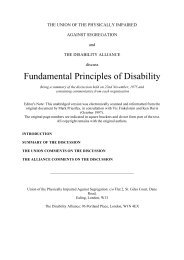Global-Report-Living-Colour-dr2-2
Global-Report-Living-Colour-dr2-2
Global-Report-Living-Colour-dr2-2
You also want an ePaper? Increase the reach of your titles
YUMPU automatically turns print PDFs into web optimized ePapers that Google loves.
132<br />
Inclusive Communities = Stronger Communities<br />
GLOBAL REPORT ON ARTICLE 19: THE RIGHT TO LIVE AND BE INCLUDED IN THE COMMUNITY<br />
Conclusion<br />
ACHIEVING THE RIGHT TO LIVE AND BE INCLUDED in<br />
the community for people with intellectual disabilities<br />
presents a multi-dimensional and complex challenge for a<br />
range of actors including families, educators, employers,<br />
community stakeholders, governments and people with<br />
intellectual disabilities themselves. If we examine the key<br />
findings from consultations with self-advocates and<br />
families, what emerges is a roadmap for public policy<br />
which will lead the process for change in our communities.<br />
Key Findings and Policy Recommendations:<br />
‰ The majority of people with intellectual<br />
disabilities have no voice or control in the<br />
decisions about where and with whom they live.<br />
Recognition of the right of each person to make<br />
decisions about their own lives will require change in<br />
legislation, societal attitudes and the role of families.<br />
It is tempting to assume that legislative reform alone<br />
will achieve this shift. However, to ensure that real<br />
change happens in people’s lives, several other<br />
important investments need to be made. First,<br />
families and people with intellectual disabilities need<br />
support to develop personal support networks in<br />
their daily lives which will enable adults with<br />
intellectual disabilities to express their voice and<br />
exercise control in their lives. This support can be<br />
developed through investment in self-advocacy and<br />
support to family based organizations and training for<br />
families. Second, supported decision making<br />
structures and processes need to be developed. While<br />
some models of supported decision making are being<br />
tested in different jurisdictions, there are only a few<br />
examples internationally of these models being<br />
recognized in law.



